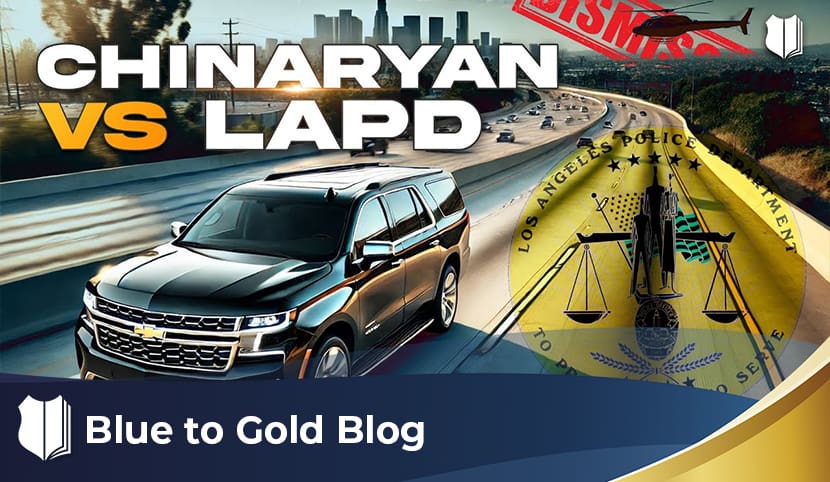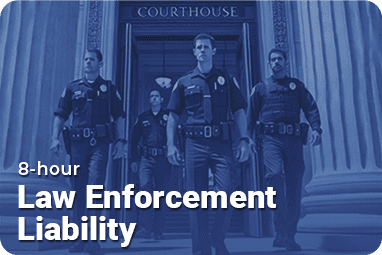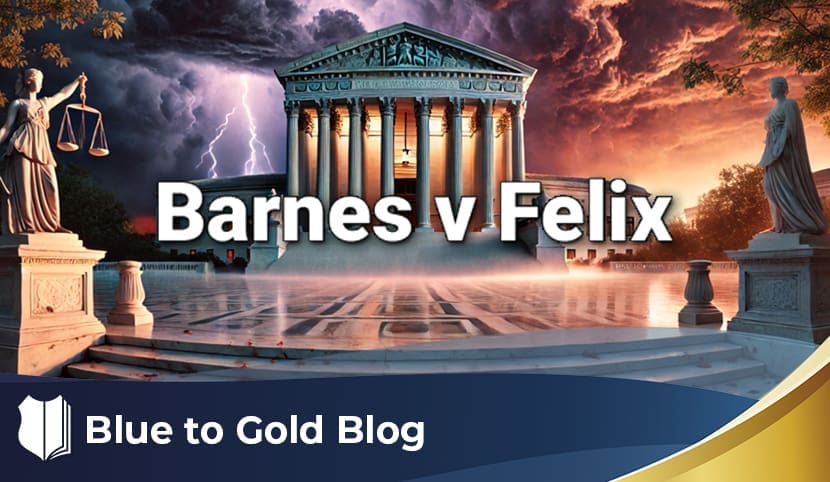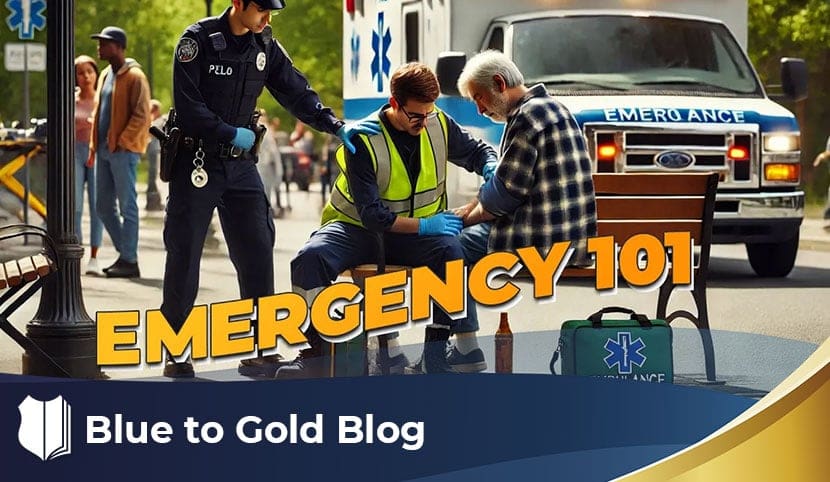Can police use highly intrusive tactics like pointing guns and proning out people during a routine high risk traffic stop for a stolen vehicle? We have to talk about Chinaryan versus the LAPD. It all begins on June 14, 2019 when the LAPD conducted a high risk traffic stop on a black Chevy Suburban with some tinted windows.
Now, we need to give you a little tee up about what kind of happened and what caused this high risk traffic stop. A vehicle was stolen, a black Chevy Suburban or Tahoe was stolen in LA about three days prior. An LAPD helicopter was in this area, this warehouse district, and it got a LoJack hit for the vehicle. Well, officers in the area are trying to track this vehicle down, and they see a black Chevy Suburban, and they run the plate. The plate came back to a Dodge Ram Pickup. We are on the right track here. It’s a very common thing for car thieves to cold plate a vehicle. They’ll switch out license plates with a legit vehicle. They’ll go to a parking lot. They’ll see a vehicle generally matching that description. They will surreptitiously put the stolen vehicle plate on that vehicle, take the cold plate, the clean plate, put that on the stolen vehicle, and hopefully nobody knows the difference. So the police ran the plate. But there was one thing; the LoJack signal was not actually coming from that vehicle. It is possible for car thieves to deactivate the Low Jack signal, right? They may have found the emitter and disabled it. So, the cops believed that they had this vehicle. Again, LoJack hit in the area, a black Chevy Suburban, it matches the description of a stolen vehicle from three days prior and it’s probably cold plated. Let’s conduct a high risk traffic stop and take care of some business.
So they call out Chinaryan and her occupants at gunpoint. You know the game here, right? “Show me your hands, come out of the vehicle, throw the keys out the window, and so on.” They get Chinaryan and her occupants out. They put them on the ground. They felony prone them out, they put them in handcuffs. They investigate, and lo and behold, that is not the stolen vehicle.
So this is like a comedy of errors, even though it’s not funny to Chinaryan. This is like a perfect storm of; not the right people that we stopped, we had the vehicle matched, they were in the area, it was not an old case, it was only three days prior, the plates are cold plated, but all this was not the stolen car. In fact, that car was not stolen at all, even the plates. The plate was off by one digit. It was the DMVs fault. The DMV mistakenly issued plates to a Dodge Ram, not to a Suburban. So there’s a Dodge Ram out there with Suburban plates, and the Suburban got the Dodge plates.
If you look at it from LA’s point of view, they stopped the right car, but they didn’t have probable cause. In other words, this is still not up to that level where we can just say, “All right, come out with your hands up, click, click, you’re under arrest.”
We still have to investigate. It wasn’t like the car was taken 15 minutes ago. It was taken three days ago. It is possible that the people driving this car really have nothing to do with the original grand larceny, right? They could be a friend of a friend driving the vehicle, and maybe they’re engaged in some other criminal activity; no license, joyriding, whatever it is, but they may or may not have had intent to steal the car.
So the cops are investigating. I think we can agree that there’s not probable cause yet for that particular person. We have probable cause that a crime has been committed, but we don’t have probable cause that this person behind the wheel is our thief, not with these facts. That’s all we know.
Okay, so now, after we dust off Chinaryan and the occupants, they’re going to sue, right? And Chinaryan wants some dough. She says, “Look, when you pointed the firearms at me, when you put me on the ground like that, all for a property crime that you only had reasonable suspicion for, you had no reason to believe that I was armed and dangerous. I want money. That’s excessive force.”
The Ninth Circuit agreed with her. Quite frankly, it’s not really the way that LAPD and law enforcement in the country have done business when it comes to stolen vehicles. We have conducted high risk traffic stops for decades. If you’re not in the Ninth Circuit, you don’t have to listen to this case. This is not binding authority on you. However, the Ninth Circuit is on to something here. You know, I do give them a hard time. I call them “Ninth Circus” and many of my colleagues do as well. They are a very liberal panel, and you have to be very careful with these guys, because they will definitely rule from the heart, not from the law books. But they’re on to something here.
Let’s just kind of talk about this. It states that officers can be held liable for conducting a high risk vehicle stop based on nothing more than reasonable suspicion of the vehicle stolen.
One of the quotes here is that it says that the Fourth Amendment protects persons from the terrifying and humiliating experience of being pulled from their cars at gunpoint, handcuffed and made to lie face down on the pavement when insufficient reason for such intrusive police conduct exists.
I kind of see where they’re coming from. I have never been pulled out of my car at gunpoint and ordered to lie on asphalt. It would be terrifying, in a sense. I mean, I don’t want to be shot. I don’t like to be at the business end of a firearm and so forth, especially if I found out later that all we have is a property crime. If you’re going to court, then all you’ve got is a stolen car. That’s all you’ve got. That’s a lot of intrusion for that crime.
I should also mention that when LAPD pulled them over, they’d been following them for about 10 minutes to get the cavalry, the helicopter. I think there were about 12 officers total. Well, there’s two officers per car, so there were approximately six LAPD vehicles involved in the stop. But while they were following them, nothing was out of the ordinary. According to LAPD, they drove correctly. They did the speed limit. They stopped at stop signs. They were not evasive. There were no furtive movements, etc. So, although vehicle theft is arguably a severe crime, the officers had no articulable basis to suspect that the plaintiffs posed a threat to anyone beyond the generic threat that I suspect the vehicle thief possesses.
As a retired Trooper, I understand that a lot of people steal cars. They just do a lot of crazy stuff to get away, but you need to articulate this. And that has been my message since 2010 when I started this business. It’s been my mission to just get my beloved police officers doing the Lord’s work out there. And yes, I say the Lord’s work. People think I’m blaspheming or something like that, but it really is the Lord’s work, to be your brother’s keeper and to also protect the society. To put your life on the line is definitely saintly. Let’s put that out there. You do such good work out there. But then when you go to court, you need to articulate things like, “All car thieves are dangerous people.” And the courts are not buying it so you have to justify what you are doing out there.
They also talked about there being tinted windows in a vehicle. We can’t see in the vehicle. Well, that’s a that’s a great safety concern, and I want to address that. This is what the Court said, “While tinted windows might justify precautions beyond the standard traffic stop, in some circumstances, police must consider less intrusive alternatives before using extreme force. And they referenced some other cases. “So here even [in an] investigatory stop, rather than a high risk stop, [we] would have addressed the officer’s inability to see into the vehicle’s rear seats from a position of cover. They could have ordered plaintiffs to step outside, lift up their clothing and turn around to reveal if they had weapons in their waistbands.”
I actually think that this is a really important quote, maybe the most important quote of the whole case, because, in all due respect, the Ninth Circuit is not saying you’re without options. They’re not saying you have to put your life on the line during these traffic stops. Now, there’s always a risk in law enforcement. You know that just as well as I do, but there are alternatives.
Let me just teach you what I have taught my clients in the Ninth Circuit that are dealing with this issue. Number one is I have told them that you cannot point a gun at or towards (even if it’s below their feet), an occupant of a stolen vehicle without specific reasons to believe that they are a danger to you. If you have the driver just got done shooting out of the car, can you point guns at everybody coming out the car? Absolutely, unless it’s a five year old, right? And don’t give me, “Well, the five year olds can be packing heat too.” Yeah, that’s true, but be careful with that. I don’t like that whole logic of the hyper vigilant stuff, right? Let’s just be rational about this. Nobody’s going to give you a hard time about making sure of the other occupants because they’re probably confederates, accomplices and so forth, right? So nobody’s going to have a problem with that. But if you’re going to point a gun at or towards somebody, you have to have reasons.
But the court also said you’re not without options. Low ready, right at your side, or Southpaw, or what one agency calls the indoor ready. You have the gun at your chest, with your hand blocking the trigger so it doesn’t snag on anything, and you’re pointing the gun low. That is permissible. That’s not at anybody. Nobody said you cannot have your gun out and ready to take care of business. Calling the person towards you with their back towards you is permissible. Yes, it’s a little higher in intrusion level, but it’s not deadly force or highly humiliating, right? Throwing the keys out the window, doing patdowns if you really believe that there could be a danger, right? You know, having them go to an officer, putting handcuffs on them is just a fight or flight reason. These are very low levels of intrusion. Handcuffs is not pointing a gun. So it’s the pointing guns at them or towards their direction, like if your body cam is showing the weapon pointing in their general direction, that’s the things we’re talking about. And it’s also spreading them out on the pavement. That is the kind of humiliation that we’re trying to prevent without some reason to believe that they are a danger, right?
Finally, the Court said defendants (that’s LAPD) cite their training and personal experience that stolen vehicles are often linked with armed and dangerous individuals. Indeed, that is why they argued that the existence of a stolen vehicle in and of itself is enough to satisfy the degree of force used. And the Court held that while the generic danger posed by stopping a cold plated vehicle may or may not justify a high risk stop, then only a jury can resolve this issue, so they’re going to give it to the jury. But let me just tell you, a California jury, or even a Texas jury would probably be persuaded that this is a little much for nothing more than a stolen car.
However, in most of your circumstances, are you going to have more than a stolen car? Are you going to have more, like looking like they’re hiding weapons or grabbing weapons? Are you going to have the delayed stop? Are you going to have them yelling at you? All this not complying with the commands and so forth. The answer is yes. Change the facts, change the answer. But at the end of the day, Chinaryan is onto something here, right? We do have to articulate what we’re doing out there.
I have been telling my students for years that if you go to court or IA, internally or externally, if you’re asked why you did something, and what you are asked about, what you did is an intrusive issue, like pointing guns, handcuffing, entering homes, and you say something like, “Well, I was trained that way. Or that’s the way I’ve been doing business for 15 years. I don’t know. I’ve never had a problem,” that is not a reason or excuse. Can you have been trained incorrectly? I know it firsthand that there are many, many cops out there that have been trained incorrectly, that they think they can do stuff that the law does not allow, and they just haven’t been caught yet, right?
You need to justify your intrusion, you need to justify what you’re doing out there. So if you can understand that pointing guns and laying people on the ground is a use of force, which it is, then you can appreciate that when you’re asked why you did it, you need something more than a generic property crime that is often associated with bad people. You’re going to need something more, but you’re not without options. Remember, you can definitely do the tactical investigatory stop, which is what LAPD does. It’s like between high risk and unknown risk. It’s right in the middle. It does give you some options to stay safe. Maybe consider that if you have one these situations.
Until next time my friends stay safe!










